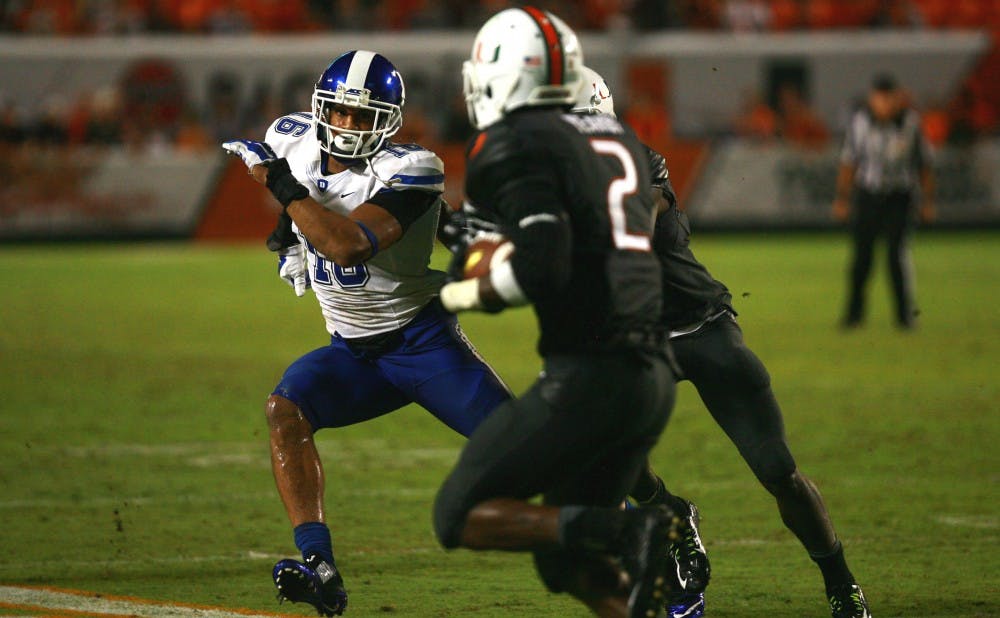Continuing our midterm evaluations of the Blue Devils as the season nears its halfway point, today is exam day for the Duke defense.
Through the first five games of the season, this year's Blue Devils are better in nearly every statistical category than they were at the same time last season. Duke is allowing 32.4 fewer total yards and 14.6 fewer points per game, and have generated more turnovers and sacks. It's worth noting, though, that last year's Blue Devils went up against three top-100 offenses in those first five games—including a pair in the top 35—but faced just two such attacks this year and none ranked in the top 80.
Duke has also improved in timely situations early in the season: opponents have converted just 28.1 percent of their third-down chances and scored touchdowns on 53.9 percent of their red zone trips in 2014, compared to 37.8 percent on third down and 64.7 percent of red zone conversions last year.
Redshirt junior safety Jeremy Cash has risen to the top of the class early on this season and has seemingly been everywhere at once for defensive coordinator Jim Knowles. The Ohio State transfer has racked up 45 tackles through five games, good for second on the team, and leads the defense with five tackles for loss. Cash has also picked up 1.5 sacks on safety blitzes and has been an opportunistic defender, recording an interception and forcing a pair of fumbles against Miami.
The defensive unit was dealt a major blow when redshirt senior linebacker Kelby Brown tore his ACL in a preseason scrimmage, sidelining the First Team All-ACC selection for the year. Senior David Helton was forced to slide over into Brown's mike linebacker spot, and redshirt senior C.J. France was inserted into the starting lineup at the will linebacker spot.
In Brown's absence, the Blue Devils have struggled to stop the run so far this season, as might be expected with the loss of their third-leading tackler from last year's squad. Duke has given up an average of 186.4 rush yards per game, and its opponents have surpassed the 200-yard threshold on the ground in each of its last three games. Miami tailback Duke Johnson found the second level multiple times in the Hurricanes' 22-10 win Sept. 27 en route to 155 yards and a touchdown.
Despite giving up a high volume of yards, the vast majority of the damage has come in bits and pieces—the Blue Devils have prevented the big play, allowing no runs of more than 28 yards so far this season. That number will be tested throughout the rest of the season against the likes of Georgia Tech and Pittsburgh, two of the nation's strongest rushing attacks.
Next up on the Duke slate are the Yellow Jackets, as the Blue Devils will travel to Atlanta to take on a Georgia Tech squad whose rushing attack ranks 11th in the country. Executing Paul Johnson's triple-option at a high level, the Yellow Jackets are chewing up 297.2 yards per game on the ground, and torched the Duke defense for 344 rushing yards last September in Durham. The Blue Devils showed they could slow down the triple-option last year when they held Navy to seven points in a blowout win, and will need a sterling effort to leave Bobby Dodd Stadium with a win.
Led by Cash, the Duke secondary has bottled up opposing aerial attacks, holding its first five opponents to less than 240 yards passing. The Blue Devils have kept receivers in front of them all season long—only two pass plays against the unit have gone for more than 40 yards, and opponents have only scored two touchdowns through the air all season, one of them on a blown coverage. Cash and secondary counterparts DeVon Edwards, Deondre Singleton and Bryon Fields—rank second through fifth on the team in tackles, respectively, trailing only Helton. Edwards has a pair of forced fumbles and an interception, and Fields recorded a pick-six against Tulane.
Overall, the Blue Devils are giving up 367.6 total yards per game, which ranks 49th in the country. If that number holds, Duke will allow less than 400 yards per contest for the first time since 2009, head coach David Cutcliffe's second in Durham.
The Blue Devils allowed more than 30 points three times in its first five games in 2013—including a brutal 58 to Pittsburgh in last year's shootout at Wallace Wade—but have been much more stingy with points so far this year. The Duke defense has allowed just 13.6 points per contest through five games, less than half of the unit's 28.6 per-game mark in the first five games of 2013. After the inauspicious start to the year, that 2013 Blue Devil squad buckled down, surrendering a more-respectable 19.3 points per game for the rest of the regular season.
Whether this year's edition of the Blue Devil defense will be able to thwart ACC offenses for a second-consecutive season remains to be seen. None of Duke's nonconference FBS opponents this season crack the top 100 in points per game, and two—Troy and Kansas—are among the bottom 10 teams in the country in that category. That said, the Blue Devil defense was fairly sound in its first ACC tilt against Miami save for two big pass plays from quarterback Brad Kaaya, holding the Hurricanes to less than 30 points for the first time since 2010.
The Blue Devils will find out just how stout its defense is as they wade deeper and deeper into ACC play. If the unit can perform at or near the caliber it showed during nonconference play, Duke has a good chance to pass its weekly test and contend for a second straight Coastal Division crown.
Get The Chronicle straight to your inbox
Signup for our weekly newsletter. Cancel at any time.

